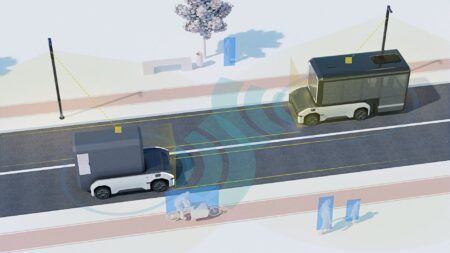Massachusetts-based MIT spin-off, WaveSense Inc., is commercializing its patented military-proven ground-penetrating radar (GPR) that significantly improves navigation safety and precision on any road by keeping self-driving vehicles precisely in-lane.
Autonomous vehicles (AV) need to become safer for broad consumer, ride hailing and trucking industry adoption. WaveSense’s patented technology complements existing self-driving vehicle sensors, such as GPS/INS, radar, lidar and cameras, to keep vehicles precisely in-lane, especially in poor weather conditions and where lane markings do not exist or are unclear and confusing. Originally developed at MIT’s Lincoln Laboratory for the military, the company’s first GPR systems were deployed in Afghanistan in conditions where road markings were poor or non-existent and obstruction from poor visibility was commonplace. WaveSense is now bringing this precision technology to civilian self-driving vehicles, with several pilots already underway with leading industry players.
Current above-ground sensor systems used by leading players in AV development to identify the exact position of the vehicle are insufficient, often handicapped by visibility issues, and struggle with weather and constant changes in the driving environment. With the addition of subsurface data to above-ground sensor information, self-driving cars will have a comprehensive capability to know their exact position at all times.
Using ground-penetrating radar, WaveSense builds a subterranean fingerprint of roadways and maps and tracks against unique geologic patterns. It scans up to 10ft (3m) below the road to lock on to stable underground features and keep AVs safely and precisely in-lane. As the vehicle drives, WaveSense continually scans the subsurface soil layers, rocks and road bedding about 126 times per second and compares the scans to its onboard image database to determine the exact vehicle position in relation to the road. This mode of navigation has been demonstrated to be accurate to within a few centimeters (approximately 1in) at standard highway speeds, even during night-time whiteout snowstorm conditions.
WaveSense’s mapping and sensor system improves navigation safety for AVs with:
Robust and precise positioning in conditions where lidar, camera and GPS can falter, such as snow, heavy rain, fog, sand and dust, tunnels, poor or missing lane markings, and dynamic dense urban settings; A map that is independent of dynamic environments above ground and adds a vital layer of security that improves overall navigation failure rates by orders of magnitude, even in clear weather; The subsurface map is highly stable compared with surface maps and, as a result, needs to be scanned and updated much less frequently; WaveSense’s proprietary algorithms determine an AV’s exact location in five-dimensional space.
“The ground-penetrating radar technology that successfully protects our troops in Afghanistan from dangerous situations will accelerate the commercialization of self-driving vehicles and will significantly reduce civilian autonomous vehicle fatalities,” said Byron Stanley, WaveSense’s CTO and co-founder. “That mission has driven our work and our passion for a decade and is what propels us forward now.”
Tarik Bolat, WaveSense’s CEO, added, “Before broad adoption of self-driving vehicles can occur, navigation safety and reliability must improve significantly. Our technology radically improves the safety of self-driving vehicles in all conditions and provides the confidence and reliability our sector must demonstrate in order to earn the public’s trust.”




